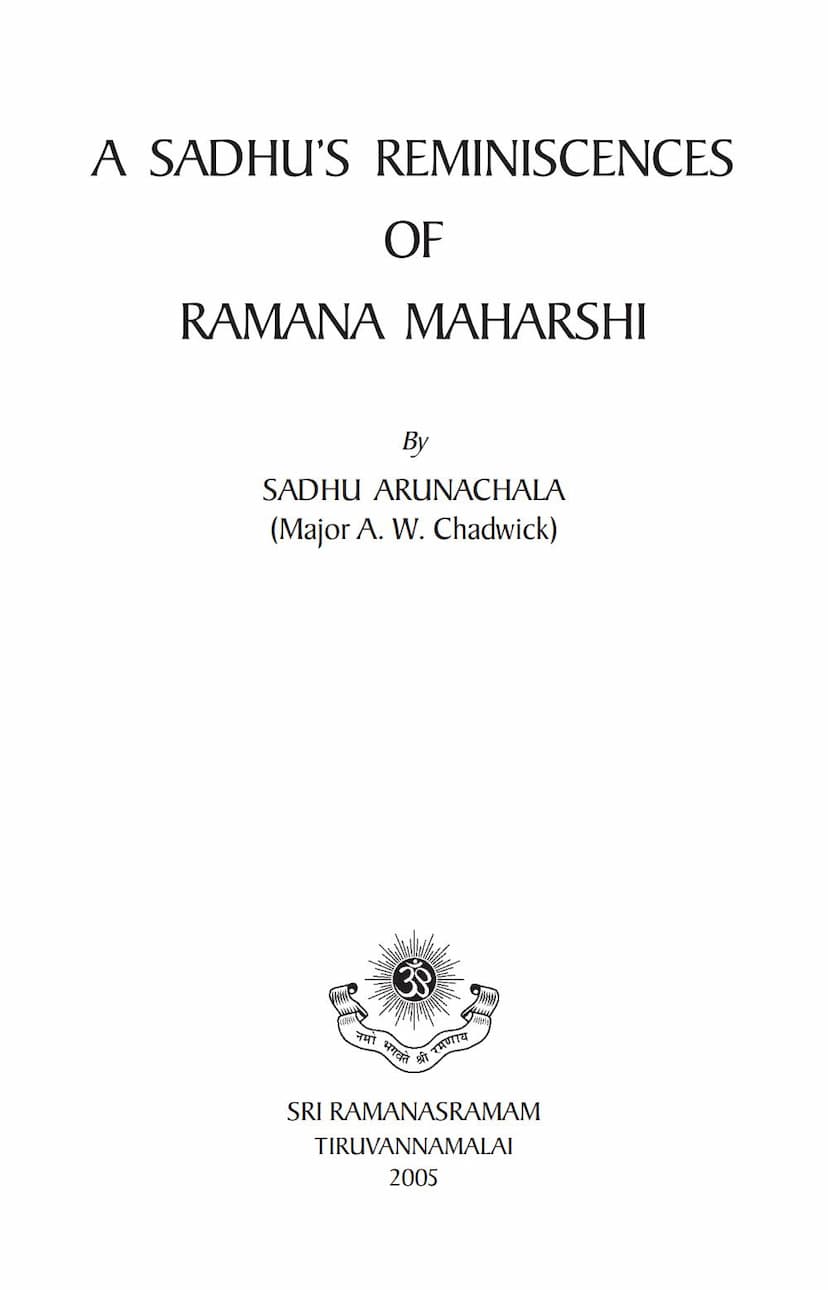Sadhus Reminiscences Of Raman Maharshi
Added to library: September 2, 2025

Summary
Here's a comprehensive summary of "A Sadhu's Reminiscences of Ramana Maharshi" by Sadhu Arunachala (Major A. W. Chadwick), based on the provided text:
Overview:
"A Sadhu's Reminiscences of Ramana Maharshi" is a personal account by Major A. W. Chadwick, an Englishman who became a renunciate (Sadhu) and dedicated his life to the teachings of Sri Ramana Maharshi. The book offers intimate insights into Ramana Maharshi's life, teachings, and the atmosphere of Sri Ramanasramam. It aims to supplement existing accounts by sharing personal experiences and observations, many of which were not widely recorded by others. The book is presented with great respect for truth and accuracy, offering a deeply personal and devotional perspective.
Key Themes and Content:
-
The Author's Journey:
- Sadhu Arunachala (Major Chadwick) was drawn from England to India by the fame of Ramana Maharshi.
- He arrived at the Ashram in 1935 and never returned to his former life.
- He describes his initial meditation practices, which aligned with Ramana Maharshi's teachings, even before arriving in India.
- He details his arrival at Tiruvannamalai, his initial interactions with Ashram residents like Ganapathi Sastry, and his settling into his room.
-
Ramana Maharshi's Nature and Teachings:
- Self-Realization: The book frequently refers to Ramana Maharshi as a fully Realized Sage, one who was always consciously one with the Supreme.
- The Death of the Ego: The central event in Ramana Maharshi's life, as recounted from his own words, is his profound realization at age sixteen, where he experienced the death of his ego and identified with the Self. This experience is described as an intense, vivid flash of truth rather than an intellectual process.
- The Method of Self-Enquiry: Ramana Maharshi's primary teaching is the path of Self-enquiry, particularly the question "Who am I?". This is presented as the direct method to discover the Self and dissolve the ego. The book "Who am I?" is highlighted as containing the essence of his teachings.
- Silence and Presence: Ramana Maharshi's silent presence conveyed immense peace. While he communicated through words, his silence was often considered the most profound teaching, especially for advanced disciples.
- Advaita Vedanta: The book delves into the principles of Advaita (non-duality), explaining that it means "Not-Two" rather than simply "One." Maya is described as "that which is not" or that which limits the limitless, and the ultimate truth lies in the impermanent nature of all appearances.
- Detachment and Non-Identification: Ramana Maharshi emphasized the importance of observing life's events without identifying with them. The body and its actions are seen as part of a dream, and the true self is the witness.
- The Nature of Mind and Thought: The mind and thought are presented as synonymous, and the ego is seen as the root of all thought. The advice is to focus on the "I" or the source from which thoughts arise.
- Acceptance and Indifference: Ramana Maharshi displayed profound indifference to worldly matters, including his own physical comfort. He never touched money, was unperturbed by external events, and accepted whatever came his way.
- Humor and Compassion: Despite his profound spiritual state, Ramana Maharshi possessed a great sense of humor and was deeply compassionate, especially towards animals. He treated the Ashram's creatures with great affection and care.
- No Fixed Rules: Ramana Maharshi did not impose rigid rules on his devotees. He encouraged them to find their own path through Self-enquiry, rather than adhering to external practices without inner understanding.
-
Personal Anecdotes and Observations:
- The Author's Meditation: Chadwick describes his personal journey of meditation and his realization that his method was similar to Ramana Maharshi's.
- Interactions with Ramana Maharshi: The book is filled with personal interactions, including conversations, Bhagavan's responses to questions, his quiet observations, and his unique way of guiding disciples.
- The "Who am I?" Book: The significance and simplicity of "Who am I?" are repeatedly stressed as the core of Ramana Maharshi's teachings.
- The Mownam (Silence): Ramana Maharshi clarified that his period of silence was not a vow but a practical choice, and he discouraged his followers from adopting vows of silence without genuine inner grounding.
- Samadhi States: The text explains different states of consciousness like Manolaya, Savikalpa Samadhi, Nirvikalpa Samadhi, and Sahaja Samadhi, placing Ramana Maharshi's state as the highest, Sahaja Samadhi.
- The Story of Somerset Maugham: The author recounts the visit of Somerset Maugham, correcting misconceptions about his fainting spell and criticizing Maugham's interpretation of Ramana Maharshi's teachings.
- Ramana Maharshi's Illness and Passing: The book details Ramana Maharshi's final illness, his refusal of drastic medical interventions, and his peaceful passing, describing the extraordinary events and the lingering presence felt by devotees.
- The Ashram and its Management: Chadwick touches upon the administration of the Ashram, the importance of the Will, and the ongoing spiritual significance of the place.
- The Nature of a Guru: The book explores the role of a Guru and the relationship between Guru and disciple, emphasizing that the ultimate Guru is the Self.
- Animal Interactions: Numerous anecdotes illustrate Ramana Maharshi's deep love and connection with animals, from squirrels and dogs to peacocks and cows.
- The Will of Ramana Maharshi: The author details the circumstances surrounding Ramana Maharshi's Will, emphasizing his consent and the legal process, highlighting it as a practical arrangement for the continued functioning of the Ashram.
Conclusion:
"A Sadhu's Reminiscences of Ramana Maharshi" is a testament to the author's profound devotion and the transformative power of Ramana Maharshi's presence and teachings. It offers a detailed, personal, and deeply spiritual account of life at Sri Ramanasramam, providing readers with a nuanced understanding of Ramana Maharshi's message of Self-realization through Self-enquiry and the power of being. The book concludes with the author's belief in the continued, albeit non-physical, presence of Ramana Maharshi, a presence deeply felt by those who visit his Samadhi.